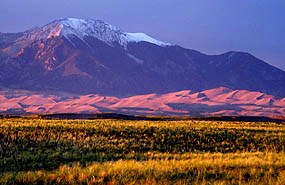
NPS Photo by Scott Hansen Sangre de Cristo National Heritage Area, Newly Dedicated, Highlights Rich History of Colorado's San Luis Valley The vast The Sangre de Cristo National Heritage Area, which includes more than 3,000 square miles of south-central Colorado, was dedicated August 29, 2009 in the back yard of two brothers who helped make it possible: Former U.S. Sen. Ken Salazar, now Secretary of the Interior, and U.S. Rep. John Salazar of Colorado. Both were born in Alamosa, CO, the valley’s largest town, and grew up in the nearby farming community of Manassa. “The cultural and historic value of the Sangre de Cristo National Heritage Area to Colorado and our nation is immeasurable,” Secretary Salazar said. He noted that the region has been home to native tribes, Latino and Anglo peoples across more than 11,000 years of settlement, leaving “an unmistakable imprint on all of those who inhabit the valley today.” The newly designated area includes three Colorado counties (Conejos, Costilla and Alamosa) and covers a landscape larger than the states of Delaware and Rhode Island combined. It is named for the range of jagged, 14,000-foot mountains that defines the eastern edge of the The Salazar brothers sponsored legislation in the House and Senate to establish the heritage area. It was formally approved when President Obama signed the Omnibus Public Lands Management Act of 2009 earlier this year. National Heritage Areas (NHAs) are congressionally designated locales where preservation of historic, cultural and natural elements in places of distinctive human influence on the landscape is encouraged. This new designation aims to help communities in the valley protect their cultural, historical and natural assets as well as spur local economic development. Besides Great Sand Dunes – whose 750-foot mounds are the tallest dunes on the continent – the heritage area contains three national wildlife refuges, a national forest and two forest wilderness areas, 15 state wildlife areas and a Nature Conservancy preserve, the Medano-Zapata Ranch. It also includes the beginnings of the Rio Grande, the third-longest river system in North America. Its cultural resources are equally impressive. The valley first drew human settlers nearly 12,000 years ago and has been home to Ute, Navajo, Apache, Tiwa, Tewa, Comanche, Kiowa and Arapaho tribes. After Spanish explorers passed through in 1776, European settlers gradually came north from Mexico. Nineteenth-century Mexican land grants triggered initial settlement by families whose descendants remain in the The heritage area also contains more than 20 cultural properties listed in the National Register of Historic Places, including the narrow-gauge Cumbres & Toltec Scenic Railroad between Antonito, CO and Chama, NM, as well as Fort Garland, the adobe outpost where Kit Carson served as commander after the Civil War. “The designation as a national heritage area will help protect these crown jewels of the American landscape by supporting a local, consensus-based approach to land management, while protecting the interest of private landowners,” Secretary Salazar said. Although the heritage area program is managed by the Park Service, the new NHA, and all others, are not NPS units. Nor does the Park Service own or manage any of the land within it except for Great Sand Dunes National Park and Preserve, northeast of Alamosa. The agency provides technical, planning and limited financial assistance to local interests. Decision-making for the new heritage area rests with local organizations and individuals, including the newly formed Sangre de Cristo National Heritage Area Board of Directors, host to the dedication August 29, 2009. Rep. Salazar and Dan Wenk, acting director of the Park Service, were scheduled to lead the ceremony in the plaza of San Luis, the historic town that also includes Colorado’s oldest church parish (Our Lady of Guadalupe) and first water right (San Luis People’s Ditch). The first NHA was designated in 1984. With the Sangre de Cristo, the program includes about 50 heritage areas in 32 states, from factory towns and city neighborhoods to farmlands and battlefields. Colorado has two others: the Cache la Poudre River Corridor NHA, designated in 1996 to mark development of water and water law in northern Colorado; and South Park NHA, another Ken Salazar initiative approved by Congress this spring to highlight the scenery and mining and agricultural history of central Colorado. The Sangre de Cristo also borders New Mexico’s Northern Rio Grande NHA, which encompasses a mosaic of ancient and modern Pueblo cultures and Spanish settlement history, including Taos Pueblo, a United Nations World Heritage Site. Partners in NHAs range from local, state and federal governments to non-profit groups and private businesses. With advice from experienced Park Service professionals, they draft and implement plans that focus on the distinct qualities that make their regions special. Collaborations can include conservation, community revitalization, economic development and more. NHAs also link diverse interests such as education, recreation, heritage tourism and historic preservation. They are meant to maintain, place by place, the physical character and cultural legacy of the United States. In a recent report to the NPS director, the National Park Service Advisory Board Partnership Committee noted that heritage areas offer “a new strategy to meet (the NPS) stewardship mission by engaging the public outside of park boundaries while recognizing the people who live there.” “National Heritage Areas knit together the whole landscape and provide an integrated approach to conserving the cultural, natural and historic resources that define sense of place and shared heritage values,” the report adds. -- NPS -- |
Last updated: February 24, 2015
